Electric heat gun: types, how to choose, review of the best manufacturers
It is impossible to quickly warm a spacious room with heating radiators or other convector heaters.Heat from appliances spreads too slowly throughout the room due to natural convection.
For efficient and fast heating, an electric heat gun with forced air circulation is more suitable. A powerful fan heater can heat up almost any size room in the shortest possible time.
There is a wide range of such units on the market, which differ from each other in the type of heating element, housing design, power and functionality. We will tell you how not to get confused in the variety and choose a heat gun by comparing its characteristics with the upcoming operating conditions.
To ensure that your purchase does not disappoint, we advise you to pay attention to trusted manufacturers - a brief overview of brands of heating equipment is presented in the article.
The content of the article:
Design and types of heat guns
A floor fan heater (also known as a “heat gun”) is a household or industrial heating device that, in addition to the heating element, has a built-in fan. The first heats the air inside the housing, and the second pushes it into the heated room.
Moreover, the circulation process occurs continuously and at high speed. This is the reason for the high efficiency of heating large areas with this type of heating equipment.When operating through a fan heater with a power of only 2–3 kW, about 200–300 cubic meters of air mass passes per hour.
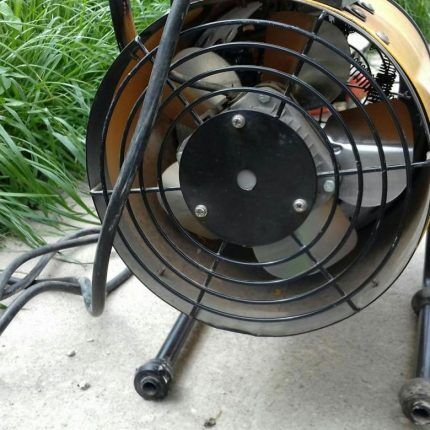
Using a heat gun to heat:
- construction sites;
- garages and workshops;
- premises for agricultural and industrial purposes;
- living rooms;
- greenhouses;
- warehouses.
It is also often used for heating or drying various surfaces: stretch ceilings, plastered walls, etc. The electric fan heater does not emit exhaust gases or toxins during operation. From an environmental point of view, this equipment is completely safe and harmless.
The electric heat gun should not be confused with its analogues - gas gun or diesel unit. It is difficult to call them environmentally friendly. With heated air, at a minimum, carbon dioxide comes out of them, large volumes of which are dangerous to health.
Electric heaters are free from this; by definition, nothing is burned in them to produce thermal energy.
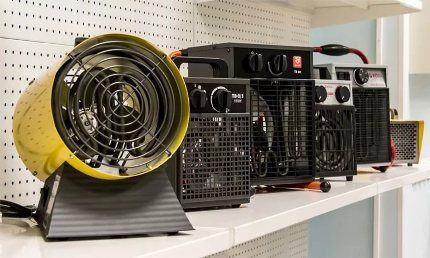
An infrared heat gun is similar to a fan heater in design and appearance. However, there is no fan as such. The transfer of thermal energy here occurs not through forced air exchange, but through infrared radiation.
That is, heat in this case is transferred directly to heated surfaces and objects using IR rays, and not through preheating the air.
Advantages and disadvantages of the unit
Among the many advantages of a heat gun operating solely on electricity are the following:
- Possibility of installation in unventilated rooms;
- long period of continuous operation;
- no open fire;
- the presence of control automation with a thermostat;
- receiving heat immediately after connecting to the power grid;
- no need to constantly add combustible fuel;
- the ability to use the gun as a regular fan;
- high efficiency when heating large rooms;
- small dimensions;
- versatility in terms of placement.
The fan heater does not emit unpleasant or harmful substances into the air. There is simply nothing to burn in it. Occasionally, when operating this appliance, a burning smell appears for a short time after power is turned on.
This is due to the accumulation of dust on the heating element and protective grille. If the gun is kept clean, then this will not happen.
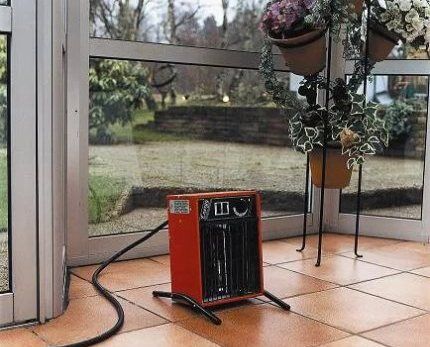
The electric heat gun is able to work unattended and continuously for several days. It does not require adding fuel. At the same time, the presence of automation guarantees that the temperature in the room will be maintained at the required parameters without human intervention.
The heating of the spiral, which heats the air in the heat gun, occurs in a matter of seconds after applying electric current.Heat almost immediately begins to flow into the heated room. In this regard, the equipment under consideration greatly outperforms other heater options.
Fan heaters are extremely easy to use. It is only necessary to prevent dust from accumulating inside, which will emit smoke when the coil is turned on. They can be placed on the floor, wall and even on the table. The range of this thermal equipment is extensive. You can find an option for any placement and any size.
The fan heater has only three disadvantages:
- “burning” oxygen and “drying” air;
- high noise level when the fan is turned on to maximum;
- power grid dependence.
When an electric heat gun operates, the air around the heated coil is naturally dried. As a result, the overall humidity in the room gradually drops, and it is impossible to escape.
A similar situation arises with oxygen: it gradually burns out due to the contact of air masses with a hot heating element.
Of course, these are not the same volumes as when operating a gas or diesel gun. But if this moment is critical, then the fan heater should be chosen not with a spiral, but with ceramic plates.
The latter are heated to lower temperatures, which greatly eliminates the disadvantages of open spiral heaters. But such models also cost a little more.
How to choose an electric heater gun
Before you go buy a fan heater, you need to clearly understand why you need a heater at all. If air heating is required occasionally and quickly, then an electric heat gun is ideal for such modes.
If the temperature needs to be maintained in the room for a long time and at a constant level, then it is better to look for another option, otherwise the electricity bills will be simply huge.
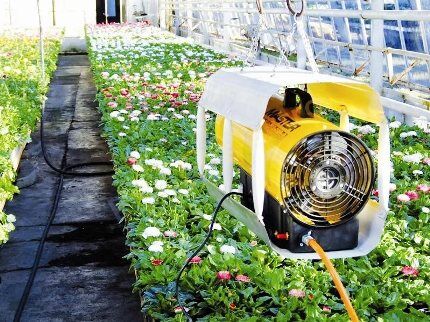
It is also necessary to determine in advance the required power (depending on the cubic capacity of the room) and power supply. Powerful industrial and semi-industrial models require three-phase voltage to operate.
If the room has only a regular single-phase socket, then the electrical equipment should be selected accordingly.
Criterion #1: heating element
The main thing in an electric heat gun is the fan. But it is standard in all models. It's hard to come up with anything unique here. But it’s worth understanding the heating element in more detail. Both the safety and, to a large extent, the power of the heating device depend on its correct choice.
There are two types of air heating elements in the fan heater:
- spirals made of high-resistance alloys;
- ceramic plates.
The first option heats up to 300–600°C, and the second only up to 150°C. However, due to the smaller area of the heating element, coils are somewhat inferior to plates in terms of efficiency.
The heat transfer surface in the first case is significantly smaller than in the second. And the fan “removes” heat from the entire heated area.

The ceramic option is more fireproof, since the temperature of the elements in such a heat gun does not rise too high. And in terms of power output and heating efficiency, models with plates are in no way inferior to their counterparts with a spiral. Moreover, the spiral burns out much more often.
If you disassemble the ceramic plate, then inside it will be the same heating coil. Only it is made of a different alloy and heats up to a lower temperature. At the same time, all the heat it creates is transferred to the ceramics, from which the thermal energy is already removed by the air flow from the fan.
The plate takes a little longer to heat up than an open spiral, but it will also last longer.
Criterion #2: Hull design
All powerful fan heaters are now available in metal versions with anti-corrosion coating. A plastic body is not acceptable here. Low-power household appliances may have plastic inserts on the casing, but most often these are rubberized handles and switches that you have to touch with your hands.
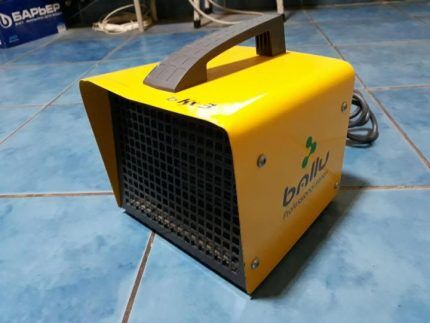
All thermal electric guns are divided into:
- Stationary models - are cheaper and have more power.
- Mobile (portable) options more compact and can be easily rotated in the desired direction. They usually have hinges that allow you to adjust the direction of the airflow by rotating the entire gun where you want it to go.
However, on sale you can also find an option with rotary dampers that deflect the air stream from the fan to the right/left and up/down.
If a heat gun has a protective dissipative mesh, it must be metal. Here any plastic is categorically unacceptable, since the temperature of the air leaving the fan heater is too high.
Criterion #3: Power
The more power a device has in kilowatts, the faster and larger the room it can heat. But as the power indicators increase, the fan noise also increases. It has to operate at higher speeds, which inevitably leads to an increase in noise in decibels.
According to a simplified scheme, the power of the fan heater is selected at the rate of 1 kW per 10 sq. m area. But this formula is valid only if the ceiling height does not exceed 3 meters. According to it, a heat gun can be selected for a garage, cottage or small workshop.
For large buildings, it is necessary to make more detailed calculations, taking into account not the square footage of the area, but the cubic volume of the room.
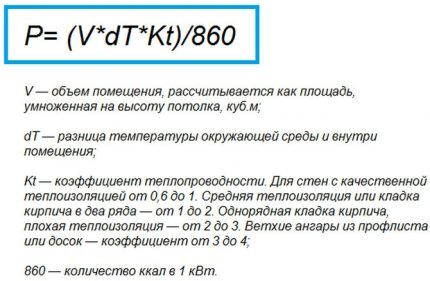
In addition to the power (kW), the technical data sheet of a heat gun with a fan also indicates the heat flow or productivity in cubic meters/hour. In most cases, 1 kW accounts for about 100–120 m3/h.
Some devices have more powerful fans that can pump more air. When choosing a model, both of these indicators must be taken into account.
For a summer residence or garage heating It is worth choosing a household option with a power of up to 3 kW. For small spaces this is more than enough.Remember, everything above 5 kW requires a three-phase network.
Criterion #4: additional features
When choosing a heat gun, you should also pay attention to the availability of various additional features.
Useful options:
- splash-proof housing – for fan heaters installed in rooms with high humidity;
- built-in air humidifiers and filters;
- thermostat for stepwise adjustment of output power;
- automatic “overheat protection”;
- “self-shutdown” function when the heating device is overturned.
Also, some models have a full-fledged automatic control unit that independently maintains the room temperature within the specified parameters. If it is available, the heat gun can be left to work completely unattended: the automation itself will turn the fan heater on/off as needed.
For more information on choosing a fan heater, see this article.
Which manufacturer should you prefer?
In domestic stores of heating equipment, electric guns can be found both imported and manufactured in Russia. In general, there is not much difference between them. Here you need to focus more on the power of the device.
But among the manufacturers there are also recognized leaders, for whose branded fan heaters you will have to overpay a little.
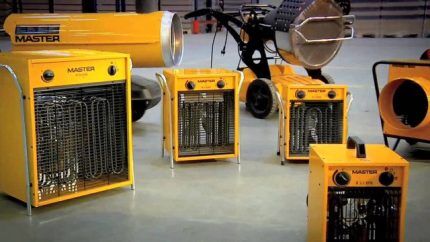
Fan heaters are produced by a fairly large number of domestic and foreign companies.
Among the main brands that have won the trust of consumers are:
- Ballu (the brand is Dutch, but production is established in Russia);
- Master (USA);
- Timberk (Sweden);
- Inforce (Russia);
- Fubag (Germany);
- Quattro (Italy);
- Tropic (Russia);
- Resanta (Latvia).
Almost all manufacturers offer heat guns in a wide range of heating power and air flow. In the existing range of this equipment, there is always a model for specific needs, you just need to correctly assess the needs.
Taking an electric gun that is too powerful and then turning it off every few minutes so as not to burn yourself is not very smart and costly.
If you want to save money, you can make your own electric gun. For assembly you will need a heating element, housing material (metal sheet or pipe), a fan and a motor.
Conclusions and useful video on the topic
To make it easier to understand the design features of different models of electric heat guns, we have made a small selection of videos with reviews and descriptions.
Design of an electric fan heater with a ceramic heater:
Which heater is better - ceramic or spiral:
How to choose a fan heater:
An example of calculating the power of a heat gun:
The fan heater allows you to almost instantly heat the air in the room to a comfortable temperature.
But we must be aware that electric heat guns with a spiral or ceramic plates are intended more for short-term heating. If you need a heater for constant use, then it is better to take a convector or an oil radiator.
Are you looking for an effective and reliable electric gun? Or do you have experience using this technique? Please leave comments on the article, ask questions and participate in discussions. The contact form is located below.




Well, I didn’t learn anything new after reading it, except for the TOP manufacturers of electric heat guns. It’s good that there are reviews of almost each of them, so you can immediately compare and choose the best option for yourself. I believe that these units have no disadvantages, and they are significantly superior to other devices for heating rooms.
I still prefer electric heat guns of our production, for example Kraton. Why overpay for brand popularity? A heat gun is good for rooms that you rarely visit. Initially, I took my heat gun to heat the garage, then took it to work in the winter. True, an incident happened, I was sitting in rubber boots right in front of the gun, they were slightly deformed.
I agree, the technology is not space-age, ours make heat guns of quite decent quality. Specifically, I know only one disadvantage with Croton - a short cord, less than a meter.